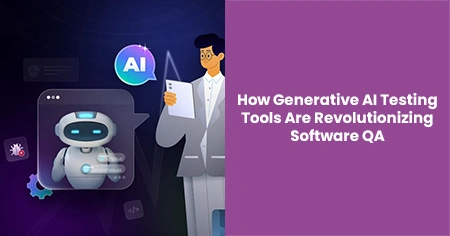This transformation isn't just incremental; it’s revolutionary. Today’s generative AI testing tools are redefining the boundaries of what's possible in software QA, allowing teams to write tests faster, detect bugs earlier, and release more reliable software at scale.
The Traditional QA Landscape: Challenges and Limitations
Before exploring how generative AI is transforming QA, it’s essential to understand the limitations of traditional testing methods:
- Manual Test Creation: Crafting test cases manually is often tedious and prone to human error.
- Time Constraints: Regression testing and maintenance often take up significant project timelines.
- Limited Coverage: Human testers can only validate a finite number of scenarios within tight deadlines.
- Brittle Automation Scripts: Automated scripts often break with UI changes, requiring constant updates.
- Delayed Feedback Loops: Testing late in the development cycle delays bug detection and correction.
These challenges have paved the way for more intelligent, automated solutions that address these pain points holistically.
What Are Generative AI Testing Tools?
Generative AI testing tools leverage machine learning models—particularly large language models (LLMs)—to generate test cases, simulate user behavior, detect anomalies, and even write and maintain automation scripts. These tools are designed to understand application workflows and autonomously create test logic based on requirements, behavior, and system patterns.
Some notable features include:
- Natural language test creation
- Autonomous test maintenance
- Intelligent test coverage suggestions
- Predictive defect identification
- End-to-end test generation
Key Benefits of Generative AI in QA
1. Speed and Efficiency
Generative AI testing tools significantly reduce the time needed to create and execute tests. With natural language input, QA engineers can generate test cases in seconds, allowing faster iteration and faster go-to-market timelines.
2. Improved Accuracy
AI-generated tests minimize the risk of human error and improve consistency across test suites. These tools can learn from past defects and generate smarter, more comprehensive tests.
3. Scalability
From startups to enterprise-level applications, generative AI adapts to scale with business needs. Whether testing a small module or a complex microservices architecture, AI ensures complete and scalable test coverage.
4. Test Maintenance Automation
One of the most critical pain points in automation testing is script maintenance. Generative AI tools like testRigor can automatically update test scripts when the application UI changes, drastically reducing manual maintenance efforts.
5. Cost Reduction
By automating repetitive and time-consuming tasks, generative AI testing tools free up QA teams to focus on exploratory testing and strategic initiatives, which lowers the overall cost of testing and enhances ROI.
Real-World Use Cases
E-commerce Platforms
E-commerce apps have rapidly changing UIs and require frequent regression tests. Generative AI can instantly adapt to UI changes and ensure product listings, checkout flows, and payment systems are thoroughly tested.
Healthcare Systems
In highly regulated industries like healthcare, accuracy is critical. AI tools can ensure end-to-end test coverage for patient records, appointment scheduling, and compliance workflows.
Banking and FinTech
Security and reliability are paramount. Generative AI tools ensure continuous testing of authentication flows, fund transfers, and real-time transaction systems, reducing the risk of system downtime or fraud.
How test Rigor Leads the Generative AI Testing Revolution
test Rigor is one of the front-runners in leveraging generative AI for software QA. It allows testers to write tests in plain English, significantly lowering the technical barrier to entry. Its platform supports:
- Test creation in natural language
- Cross-platform testing for web, mobile, and desktop
- Test suite self-healing when UI changes occur
- Seamless CI/CD integration
Through intelligent automation, testRigor has enabled companies to achieve:
- 90% reduction in test maintenance time
- 95% increase in test coverage
- Faster regression cycles by over 80%
Future of Generative AI in Software Testing
The goal is to–
Identify areas for improvement on your site elements. It can be- structure, content, technical aspects, and backlink profile.
As generative AI evolves, its capabilities will continue to expand into areas such as:
- Autonomous Test Strategy Generation: AI will soon suggest optimal testing strategies based on code changes and user data.
- Self-Correcting Test Cases: Tools will be able to detect failed tests and automatically repair them.
- Synthetic Data Generation: AI will create realistic test data that mirrors production environments.
- Visual Testing and UX Analysis: AI will analyze visual and behavioral changes to ensure aesthetic consistency and usability.
With these advancements, QA professionals will evolve from manual testers into quality strategists and AI supervisors.
Addressing Concerns: Is AI Replacing QA Engineers?
One common concern is whether generative AI will replace human testers. The short answer is no—at least, not entirely. Instead of replacement, we’re witnessing augmentation. AI takes over the repetitive, rule-based tasks, while human testers focus on areas requiring critical thinking, creativity, and empathy.
Think of AI as your co-pilot: It accelerates your workflow, helps you detect issues faster, and expands your testing horizon—but you’re still in control of the journey.
Best Practices for Adopting Generative AI Testing Tools
If you're considering integrating generative AI into your QA process, here are a few recommendations:
- Start Small: Begin with a pilot project to evaluate performance and team adaptation.
- Train Your Team: Educate your QA team on how AI tools work and how to interact with them effectively.
- Integrate with CI/CD: Ensure that your AI testing tool fits seamlessly into your existing DevOps pipeline.
- Monitor and Measure: Continuously analyze the effectiveness of AI-generated tests and fine-tune your strategy.
SEO audits deliver just that. They identify technical errors like slow loading times and difficult navigation. You also get fixable suggestions.
Conclusion
Generative AI testing tools represent a paradigm shift in software quality assurance. By enabling faster, smarter, and more scalable testing, they empower QA teams to meet the demands of modern software development without compromising on quality. As the technology matures, it will further elevate the role of QA from gatekeepers to enablers of innovation.








